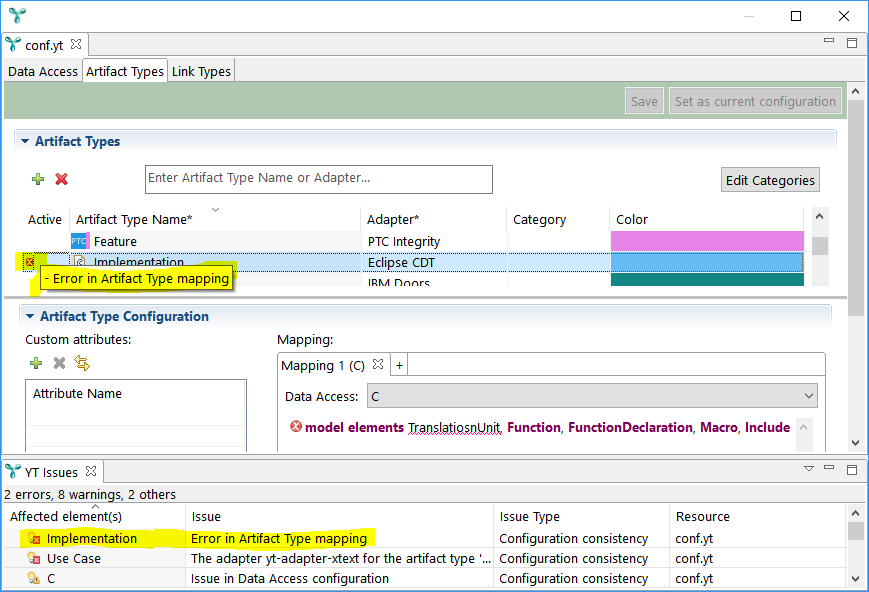Table of contents
FM1 (1.1.1701) Copy link to clipboard
Improvements of XML adapter Copy link to clipboard
We updated the XML and XPath framework which is used under the hood of YT. This does not only improve the performance of the XML adapter, it also faciliates the evaluation of substrings. Think of an XML such as
<testcase id="12"> <Req data="id=r44,status=approved"/> <Req data="id=r47,status=approved"/> ... </testcase>
In this case, YT can extract the requirement IDs r44 and r47 based on a configuration similar to
...
map{
reqIDs to valueOf("Req/substring-before(substring-after(@data,'id='),',')")joined with separator ";"
}
...
Improvement of Enterprise Architect adapter Copy link to clipboard
Link types mapped with the EA data access can now be configured to recognize an UML relation as a trace link in opposite direction.
Let’s say we have a dependency in UML from DesignDetail to Design (i.e., DesignDetail is dependent, Design is supplier). In this case, YT can be configured to recognize this relation as trace link from DesignDetail to Design or in opposite direction. Before, YT always recognized such relations as being directed from the owner to the related element (i.e., from DesignDetail to Design ). A link type configuration of
link source is B
configures YT to recognize the relation in opposite direction.
Better error handling if DOORS cache is corrupt Copy link to clipboard
When the DOORS cache was corrupt, you had either had to delete it manually from disk or by means of YT. The latter required entering a sequence of commands
- Deactivate data access "DOORS"
- Choose Update DOORS data
- Reactivate data access "DOORS"
We improved the usability in such cases by means of a notification dialog which encapsulates the above sequence.

Improvements of YT Overview Copy link to clipboard
It is now possible to choose whether the graph in the YT Overview is calculated by evaluating links in direction „from A to B” or bidirectionally.

Improvements of YT Configuration Editor Copy link to clipboard
- We made the auto-completion in the mapping area for data access, artifact types and link types a little smarter: When entering strings, the recognition of the closing double quote has been improved so that the auto completion does no longer insert two double quotes at the end of Strings.
- Issues that were found during the validation of configuration consistency are now not only listed in the YT Issues view, but also marked in the YT Configuration editor.

YT prevents evaluation or validation during data load Copy link to clipboard
When triggering a validation or a report creation, YT notifies the user that the result of the current operation may be based in incomplete data and offers the choice to validate immediately or to wait until data are loaded completely.

Order of columns of Artifact Search Dialog can be adjusted by the user Copy link to clipboard
You can now order columns or change the width of columns. The changes are specific for the chosen artifact type which means that you can define different layouts for different types. Once adjusted, the layout is stored as a preference on your disk so that your adjustments are applied valid if YT is closed and re-opened.

Query language supports AND and OR Copy link to clipboard
The expressions in the where clause of the query language now support the combination of conditions by && (and), || (or) and () (brackets specifying precedence), e.g.
query "All Test Results with exactly three incoming links"
source (linkedArtifacts('Test Result'))
.collect(Name as ArtifactName)
.where(LinksAsB.size > 2 && LinksAsB.size < 4)
Bug fixes Copy link to clipboard
Fix in YT Editor Copy link to clipboard
We fixed a bug in the YT Editor regarding the labels of sections Artifact A and Artifact B:
In multiple types mode, i.e., when a section is populated with artifacts of more than one artifact type, the label does no longer append the role configured for one of the associated link types. Instead, it simply states multiple types.

Fix regarding YT Favorites view Copy link to clipboard
We also now prevent the YT Favorites view from pushing to the front.
Before, the view was pushed to the front during startup of YT even if you put another view in front of the YT Favorites view within a prior session.
